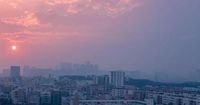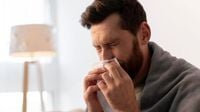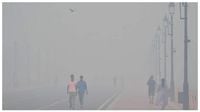Delhi’s familiar post-Diwali haze has returned with a vengeance, and this year’s smog is more than just an eyesore—it’s a public health emergency affecting millions. As the city’s skyline disappears behind a thick, gray curtain, photojournalists from ThePrint have captured haunting images of smoggy mornings and desperate clean-up efforts along the Yamuna ahead of Chhath Puja. But the visuals only tell part of the story. The numbers, and the voices of citizens and experts, paint a picture that’s even grimmer.
According to a survey released on October 26, 2025, by LocalCircles and reported by Mint and ETV Bharat, three out of four households in the Delhi-NCR region are already grappling with the effects of toxic air. The survey, which polled over 44,000 residents across Delhi, Gurugram, Noida, Faridabad, and Ghaziabad, found that 42% of households reported at least one member suffering from sore throat or cough. Another 25% experienced burning eyes, headaches, or trouble sleeping, while 17% cited breathing difficulties or aggravated asthma. The elderly, children, pregnant women, and those with chronic health conditions are feeling the brunt of this crisis most acutely.
“Three out of every four people have been affected by pollution,” said Sachin Taparia, director of LocalCircles, as quoted by ETV Bharat. The survey also revealed how people are coping: 44% are minimizing outdoor exposure and boosting their intake of immunity-boosting foods and drinks. Nearly a third have consulted or plan to consult doctors for pollution-related ailments—a testament to just how pervasive the health impacts have become.
But what’s fueling this toxic air? Data from the Central Pollution Control Board (CPCB) shows that PM2.5 levels—a measure of fine particulate matter that can lodge deep in the lungs—soared to a five-year high of 488 micrograms per cubic metre after Diwali. That’s more than three times the pre-festival level of 156.6 micrograms per cubic metre. The spike peaked on October 20, Diwali night, and the following morning, according to Mint and ETV Bharat. Despite a 77.5% reduction in stubble burning in neighboring Punjab and Haryana, thanks to floods and delayed harvests, the capital’s air quality index (AQI) remained stubbornly poor, crossing 400 in several areas—about 24 times higher than the World Health Organization’s recommended level for PM2.5 exposure.
At some monitoring stations, like Anand Vihar, the AQI hit a staggering 415, categorized as “severe.” The overall AQI for Delhi hovered in the “poor” category at 261 on October 25, down slightly from 290 the previous day, but still well above safe limits. The city’s air has become so hazardous that even basic outdoor activities are now a health risk.
The symptoms residents are experiencing—coughing, sore throats, burning eyes, headaches, and disrupted sleep—are just the tip of the iceberg. Doctors warn that the real danger lies in the long-term effects of breathing such polluted air. Dr. Amit Batra, Director of Neurology at Max Super Speciality Hospital, Patparganj, explained to Financial Express that “air pollution is a hidden cause of sinus problems and migraines. Fine particles like PM2.5 and PM10, nitrogen oxides, and ozone irritate the nasal passages. This causes swelling in the sinuses, leading to blockage, facial pressure, congestion, and headaches. For migraine sufferers, these triggers can set off a full migraine attack.”
Dr. Aditya Gupta, Director of Neurosurgery at Artemis Hospital, Gurugram, added, “Polluted air contains dust, smoke, vehicle exhaust, and industrial emissions that can inflame the sinuses. Even healthy people sensitive to air quality may develop sinus problems during heavy pollution days.” He further explained that airborne irritants can cause inflammation in blood vessels and release substances in the brain that worsen migraines. Children, the elderly, and people with chronic sinus or migraine conditions are at the highest risk, but even those without pre-existing conditions aren’t safe.
It’s not just about headaches and sinus trouble, though. According to Congress general secretary Jairam Ramesh, India’s air pollution crisis is “a full-blown assault on our brains and bodies, no longer just a respiratory issue,” as he posted on X and was quoted by Business Standard. Ramesh cited the State of Global Air 2025 report, noting that in 2023, approximately 2 million deaths in India were linked to air pollution—a staggering 43% jump since 2000. Nearly 9 in 10 of these deaths were attributed to non-communicable diseases like heart disease, lung cancer, diabetes, and even dementia. He pointed out that India records around 186 air-pollution deaths per 100,000 people, more than ten times the rate in high-income countries.
“Air pollution accounts for about 70% of COPD deaths, about 33% of lung cancer deaths, about 25% of heart-disease deaths, and about 20% of diabetes deaths in India,” Ramesh emphasized. He also highlighted new research linking PM2.5 exposure to brain damage and accelerated cognitive decline, with about 626,000 dementia deaths globally in 2023 tied to air pollution. “Air pollution is a public-health catastrophe and a national-security threat to our society, our healthcare system, and our future workforce,” he warned.
Ramesh was sharply critical of India’s current air quality standards. “Our present standard for PM2.5 is 8 times the WHO guideline for annual exposure and 4 times the guideline for 24-hour exposure. Despite the launch of the National Clean Air Programme (NCAP) in 2017, PM2.5 levels have continued to rise and shockingly now every single person in India lives in areas where PM2.5 levels far exceeds the WHO guidelines,” he said. He called for a radical revision of the NCAP and an urgent update of the National Ambient Air Quality Standards, which have not been revised since November 2009.
So, what can people do to protect themselves while policymakers debate solutions? Health experts recommend staying indoors during periods of very poor air quality, using air purifiers at home, and wearing masks when venturing outside. Saline nasal sprays can help keep nasal passages moist, and avoiding outdoor exercise during smog-heavy hours is a must. Managing sinus health and steering clear of known triggers can significantly reduce headaches and migraines caused by pollution, according to Dr. Gupta.
LocalCircles has called for strict enforcement of anti-pollution measures under the Graded Response Action Plan (GRAP), including the deployment of smog guns and night-time sweeping to reduce dust. But for many Delhiites, these measures can’t come soon enough. The sudden exposure to smoke, toxic gases, and fine particulate matter has left the city’s most vulnerable residents—children, the elderly, pregnant women, and those with chronic illnesses—struggling to cope.
Delhi’s post-Diwali smog isn’t just a seasonal nuisance anymore. It’s a crisis that’s choking the city’s future, one breath at a time. Until the air clears and long-term solutions take root, residents are left to navigate a world where simply stepping outside can be a gamble with their health.






